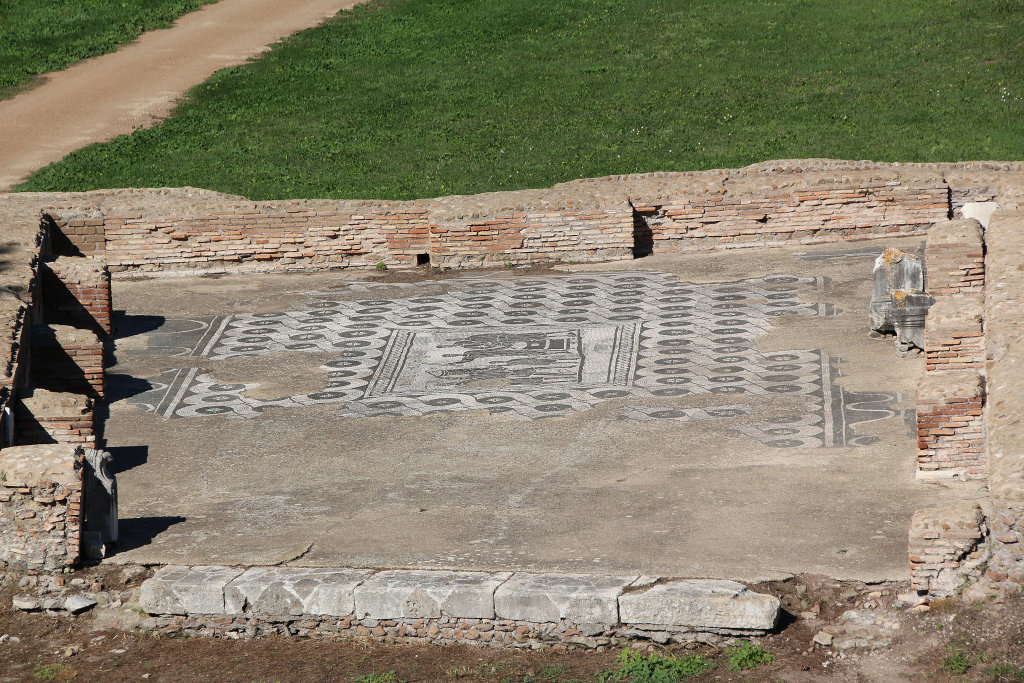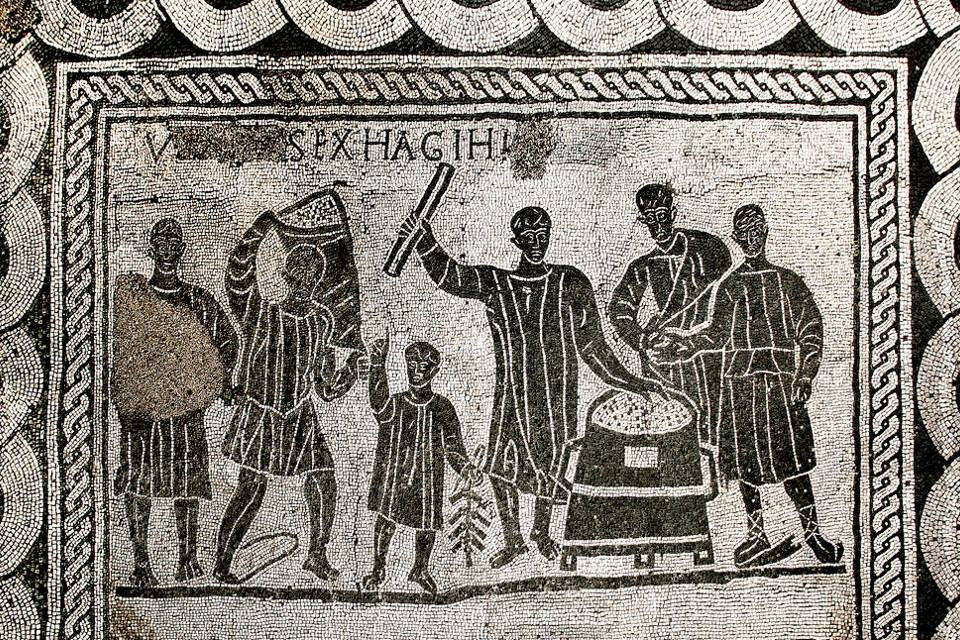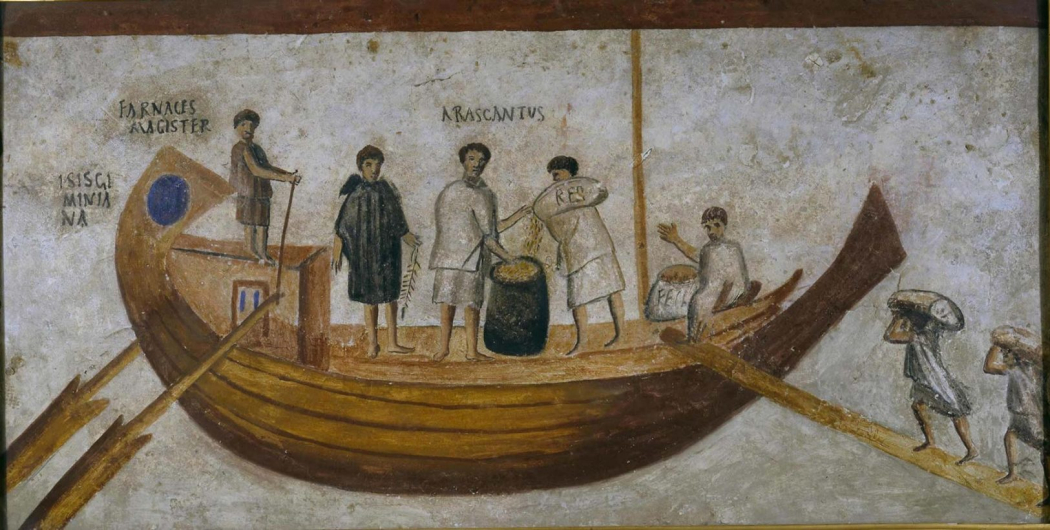|
The Hall of the Grain Measurers (I,XIX,3) is a more or less rectangular hall that was accessible from Via della Foce through an entrance seven metres wide. A room behind the Temple of the Grain Measurers (I,XIX,2) and building I,XIX,1 are annexes of the Hall. The oldest masonry (opus latericium and mixtum) is Trajanic (c. 112 AD). Alterations in brick have been dated to the late-Severan period. Originally the ceiling of the hall was carried by a perimetral wall on the west and north side, and by pilasters set against the west wall and on the east side. Later the thickness of the walls was doubled, and new pilasters were added. On the floor is a black-and-white mosaic, with a few tesserae of blue glass paste. It belongs to the rebuilding of the third century. Depicted are grain measurers (mensores frumentarii) at work. A panel with figures (3.80 x 2.70 metres) is surrounded by a geometric motif. The first person from the left is rather damaged. There is a single blue tessera between his eyes. The second is carrying a sack with grain. Next comes a small figure (a slave?). His right hand is raised. Minaud has pointed out that with his hand and fingers he is indicating the number 9. In his left hand (with some blue tesserae) is an object looking like a branch, in reality an instrument attached to the hand. It is a rope with nine tickets, presumably of wood, used to count the number of sacks that had arrived from the harbour (not an abacus). The right half of the mosaic is taken up by three people around a grain measure. To the left is the actual measurer (mensor). In his right hand is a leveling stick (rutellum). In the centre is a porter who has just emptied a sack, or is about to take the contents of the measure to a warehouse. The person at the far right is indicating the number 5000 with his right hand. The scene is in some respects similar to the famous painting of the unloading of the Isis Giminiana, that may also show measurers (from Ostia, now in the Vatican Museums). There were three sections within the guild: nauticarii, acceptores and adiutores. The first checked the grain on its arrival in the harbour, the second on arrival at the warehouses, the third when it was sent to Rome. According to Minaud's calculations the measure contained 25-27 modii, i.e. 214-234 litres or 400-432 sextarii. The sack contained 24.5-26.5 litres, or 44.5-48.5 sextarii. The relation between the sack and the measure is 1:8.8, which means that the measure was filled with nine sacks. This number coincides with the number 9, indicated by the small figure, and the nine tickets. Presumably a ticket was given to the porters in the harbour, and attached to the rope when the porter had reached the grain measure. The number 5000 must be a reference to 5000 sextarii, the contents of twelve grain measures, that had been handled by this team in one day. Above the figures is the inscription
Becatti has suggested v[ilici] sex h(orreorum) Agi(lianorum) hi[c], "Here are six attendants from the Horrea of Agilianis". According to Jouanique we should read u[ltro] sex(tarios) ha(bes) g(ran)i hi[c], which is not convincing because of the extreme abbreviations, and granum instead of frumentum. Minaud suggests V [milia] sex(tariorum) h(odie) agi(tata) hi[c], "Five thousand sextarii were handled here today". Near the edge of the mosaic a cube that has been called a grain measure and a rutellum can be seen. A marble cippus was found in the hall that once supported a statue. It has an inscription mentioning a patron of the guild (corpus) of the measurers:
Other inscriptions mentioning the guild were found not far away, to the east, opposite the Horrea of Epagathus and Epaphroditus and in the House of the Harbour Mosaic. Behind the temple is a small courtyard with a well and two basins. To the east of this courtyard is a latrine. These features are related to banquets held by the guild. Buildings I,XIX,1-3 are obviously a guild complex, but the function of the hall remains uncertain. |
 Plan of the guild complex. After SO I. |

The hall seen from the south-east. Photo: Klaus Heese.

The east part of the complex. Photo: Jan Theo Bakker.

The latrine in the east part of the complex, seen from the east. Photo: Klaus Heese.

The mosaic in the hall, seen from the east. Photo: Jan Theo Bakker.

Detail of the panel of the mosaic in the hall. Photo: Bill Storage.

The left part of the mosaic. Photo: Klaus Heese.

The right part of the mosaic. Photo: Klaus Heese.

Detail of the left hand of the small person. Note the use of blue tesserae.
Photo: Jan Theo Bakker.

Detail of the person on the left. Note the blue tessera between his eyes.
Photo: Simon Bakker.

A grain measure (?) and a rutellum near the edge of the mosaic.
Photo: Jan Theo Bakker.

The marble cippus with inscription in the hall.
EDCS-62101289. Photo: Jan Theo Bakker.

The painting of the ship Isis Giminiana. Note the second person from the left, holding an object looking like a branch.
Photo: Vatican Museums.